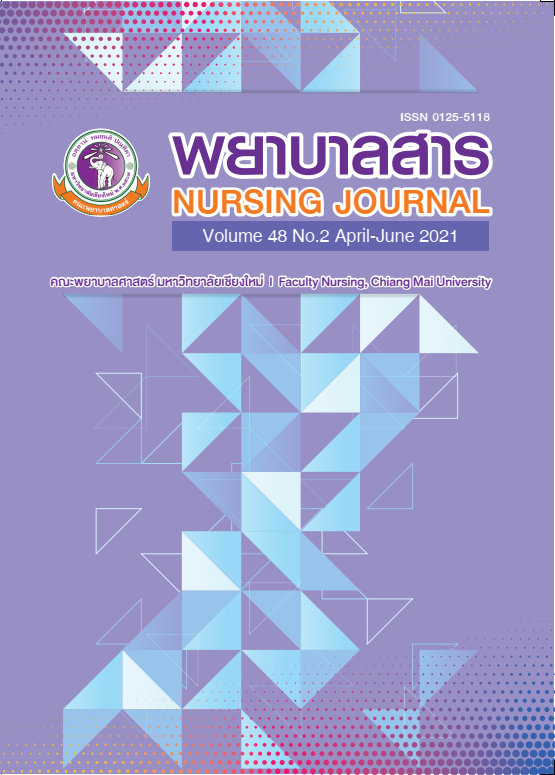Knowledge, Attitudes, and Practices Regarding Central Line-Associated Bloodstream Infection Prevention Among Registered Nurses
Keywords:
Knowledge, Attitudes, Practices, Central line-associated bloodstream infection prevention, Registered nursesAbstract
Central line-associated bloodstream infection (CLABSI) is a leading cause of death in patients. The practices of registered nurses are very important in preventing CLABSI. This descriptive correlational study aimed to examine the knowledge, attitudes, and practices of registered nurses regarding CLABSI prevention, and to study the relationship between knowledge, attitudes, and practices of registered nurses regarding CLABSI prevention. The participants were 268 registered nurses who were working in the intensive care unit, medical wards, and surgical wards in three tertiary hospitals under the Department of Medical Services, Ministry of Public Health. Data were collected between June and September 2017. The Research instrument was a questionnaire that consisted of four parts: demographic data, knowledge of CLABSI prevention, attitudes towards CLABSI prevention, and practices of CLABSI prevention. The content validity of questionnaire was examined by five experts. The content validity index was 1.0. The reliability of the knowledge, attitudes, and practices questionnaire were .81, .70 and .93 respectively. Data were analyzed by using descriptive statistics. The relationship between knowledge, attitudes, and practices of registered nurses regarding CLABSI prevention was analyzed by using the Spearman Correlation Coefficients.
The research findings showed that the participants had knowledge of CLABSI prevention at a moderate level with a median score of 11 out of 17 points. The samples participants had highly positive attitudes regarding CLABSI prevention at a high level with a median score of 52 out of 64 points, and practice was at a high level with a median score of 45 out of 51 points. It was also found that the participants’ knowledge of and attitudes regarding CLABSI prevention were positively correlated at with a statistical significance of .01 (r = .258). The knowledge and practices of the participants’ regarding CLABSI prevention were positively correlated at with a statistical significance of .01 (r = .191). The attitudes and practices of the participants’ regarding CLABSI prevention were positively correlated at with a statistical significance of .01 (r = .332).
The results of this research can be used as baseline information and guidance on planning to promote knowledge, attitudes, and practices regarding CLABSI prevention among registered nurses in hospitals under the Department of Medical Services, Ministry of Public Health.
References
Centers for Disease Control and Prevention. (2016). Central Line-Associated Bloodstream Infection (CLABSI) and non-central line-Associated Bloodstream Infection. Retrieved from http://www.cdc.gov/nhsn/pdfs/pscmanual/4psc_clabscurrent.pdf
Guembe, M., Bustinza, A., Sanchez Luna, M., Carrillo-Alvarez, A., Perez Sheriff, V., & Bouza, E. (2012). Guidelines for preventing catheter infection: Assessment of knowledge and practice among paediatric and neonatal intensive care healthcare workers. The Journal of Hospital Infection, 81(2), 123-127. doi:10.1016/j.jhin.2012.02.010
Kamput, P. (2012). Nursing competencies in semi-critical care in a tertiary hospital. Thesis, Christian university. (in Thai).
Rachavithi. (2015). Indicators of quality, Rachavithi hospital. Retrieved from http://110.164.68.234/kpiprp/ main_firstpage.php?module=report&date1=2014-06-01&date2=2014-06-30&Page=3
Rosenthal, V. D., Maki, D. G., Rodrigues, C., Álvarez-Moreno, C., Leblebicioglu, H., Sobreyra-Oropeza, M., . . . Fernández-Hidalgo, R. (2010). Impact of International Nosocomial Infection Control Consortium (INICC) strategy on central line-associated bloodstream infection rates in the intensive care units of 15 developing countries. Infection Control and Hospital Epidemiology, 31(12), 1264-1272. doi:10.1086/657140
Schwartz, N. E. (1975). Nutritional knowledge, attitude, and practices of high school graduated. Journal of the American Dietetic Association, 66(1), 28-31.
Yamane, Taro. (1973). Statistics and Introduction Analysis. 3. New York: Harper & Row.
Downloads
Published
How to Cite
Issue
Section
License
บทความที่ได้รับการตีพิมพ์เป็นลิขสิทธิ์ของวารสารพยาบาลสาร
ข้อความที่ปรากฏในบทความแต่ละเรื่องในวารสารวิชาการเล่มนี้เป็นความคิดเห็นส่วนตัวของผู้เขียนแต่ละท่านไม่เกี่ยวข้องกับมหาวิทยาลัยเชียงใหม่ และคณาจารย์ท่านอื่นๆในมหาวิทยาลัยฯ แต่อย่างใด ความรับผิดชอบองค์ประกอบทั้งหมดของบทความแต่ละเรื่องเป็นของผู้เขียนแต่ละท่าน หากมีความผิดพลาดใด ๆ ผู้เขียนแต่ละท่านจะรับผิดชอบบทความของตนเองแต่ผู้เดียว






